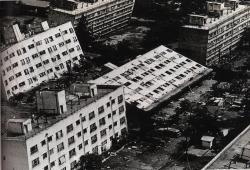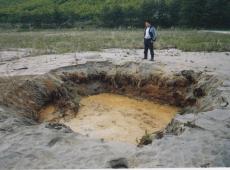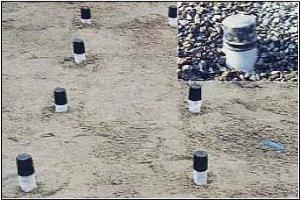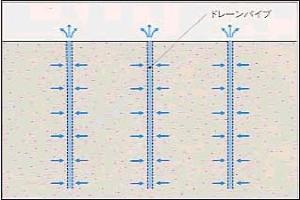- Yokohama-shi Top Page
- Disaster prevention and emergency services
- Disaster Prevention and Disasters
- Map of disaster prevention
- Liquefaction map
- Q&A related to liquefaction phenomenon
Here's the text.
Q&A related to liquefaction phenomenon
Last Updated May 27, 2021
- Q1. What does "liquefaction phenomenon" mean?
- Q2. I understand that the land I am planning to build a building is a liquefaction-friendly ground, what should I do?
- Q3. It is said that a place with bad ground is okay if it is a solid foundation, is it true?
- Q4. Is middle- and high-rise buildings such as condominiums OK on liquefaction-friendly grounds such as landfills?
- Q5. What measures should be taken in a detached house?
- Q6. I often hear that landfills are dangerous because the ground liquefaction occurs during an earthquake, but what measures are being taken in Yokohama landfills against earthquakes?
A1.
The liquefaction phenomenon was highlighted in the Niigata Earthquake that occurred in 1964. Many buildings and bridges have subsided or collapsed in Niigata because the thick sand layer, which had been trusted as the ground supporting the building until then, softened in an instant.
Liquefaction was also widely reported in the Great East Japan Earthquake, the Great Hanshin-Awaji Earthquake, the Western Tottori Earthquake, and the Geiyo Earthquake.
The particles of soil overlap in the ground. These soil particles are chewing, and in the ground below the groundwater level, there is groundwater in the gap. However, if it is shaken left and right by an earthquake, the mesh of soil particles will gradually come off. Finally, the soil particles fall apart and float in the groundwater. This is the liquefaction phenomenon.
Damage caused by liquefaction is mainly classified into the following two categories.
- Sinking and slope of buildings, etc. generated by a decrease in the support force of the ground
- Damage caused by erupting sand (a phenomenon in which water and sand erupting from underground)
The most likely ground to liquefaction is a sand ground board, a loose sand ground board, and a ground where groundwater exists at a shallow depth near the ground surface. Conversely, even if it is a sand basin, it is said that liquefaction is unlikely to occur when it is not immersed in groundwater or when ground improvement is made.

Collapse of an apartment due to liquefaction
(1964 Niigata Earthquake / Kawagishi-cho, Niigata City)

Huge sand pores due to liquefaction
(1983 Central Sea of Japan Earthquake/Hariki Village, Aomori Prefecture)
※Excerpt from "Liquefaction Map and Countermeasures Method" (Gyosei)
A2.
I don't give up right away just because the ground is bad. The building can be built soundly by properly grasping the ground with numbers and taking appropriate appropriate measures.
Refer to the liquefaction map, conduct a ground survey for places where there is a high possibility of liquefaction, and grasp the situation such as strata and groundwater level.
In addition, since it is difficult to judge liquefaction by simple methods such as Swedish sounding, it is recommended that a boring survey be conducted as much as possible.
It is difficult to grasp the properties of the ground just by looking at it. If you start by knowing the properties of the land to be newly purchased or the ground to be built, you can reduce the damage by taking measures to strengthen the seismic performance of the ground and the building. I can do it.
※What is Swedish sounding?
A simple survey method to examine the strength of the ground. A screw-shaped stick is inserted into the ground to determine the strength of the layer of the ground that has been rotated and penetrated.
A3.
The "beta basic" is a plate-shaped whole foundation of reinforced concrete, and is used separately from the "cloth foundation" where reinforced concrete is installed in a band only in the main part of the lower part of the building.
In other words, while the foundation supports the building on the surface, the cloth foundation supports the load with a line. Therefore, the solid foundation is said to be a sturdy foundation than the cloth foundation because the reinforcing bar is inserted vertically and horizontally into the mesh, and due to the structural characteristic that it is difficult to deflection, it is a foundation that can be expected to have the effect of equalizing the effect of equalizing the settlement (called uneven settlement).
The base is very effective as a measure to prevent uneven settlement, so it is often used in soft ground. That's why it's not perfect if it's the basis.
- The self-weight of the foundation itself becomes heavier, which stimulates the soft ground.
- If the ground balance is poor, it may lead to uneven settlement.
There are disadvantages such as these, and when hiring, professional judgment is required.
In addition, whether the basic foundation can be adopted is based on the fact that the surrounding area is wide flat and there is no undulation, that the stratum has not changed, that there is no foreign matter in the embankment, or that it is well-balanced based on the results of the ground survey. Preconditions such as being known in advance that the ground is good.
In addition, in the "Great East Japan Earthquake" that occurred on March 11, 2011, houses on the basement were also affected by land subsidence due to liquefaction. Since the weight of concrete is heavy on the base, there is a problem as a countermeasure against liquefaction.
A4.
Once liquefaction occurs, the ground that supported the load of the building until then becomes like a fluid, and the foundation penetrates into the ground and the building tilts, and conversely, blows up from underground There are two phenomena when the foundation is lifted by water and sand (filling sand). If you lose the support of the ground, the building will tilt due to sedimentation or uplift.
In the Great Hanshin-Awaji Earthquake, liquefaction occurred on an unprecedented scale, and buildings were tilted in artificial islands Port Island, Rokko Island, and reclaimed land in the coastal area, but middle and high-rise buildings such as condominiums Liquefaction damage was relatively small.
It is said that the building was reached with a support stake to the hard ground, and the stake and the building were tightly fixed, so that both uplifts and sinks were prevented.
However, even if there is no subsidence or uplift due to the pile foundation structure, if the surrounding ground subsides due to liquefaction, public utilities facilities such as water, gas, sewage, etc. are buried underground, so if these facilities are damaged, there is no danger of life, but it is necessary to take measures against liquefaction.
It is recommended that you consult with a contractor or expert about what kind of design and structure your building is built.
A5.
In detached houses, it is not generally possible to take measures against liquefaction by hitting dozens of meters of support piles like middle- and high-rise buildings. The reason for this is a significant increase in construction costs, but it may require a fairly large construction space to strike a robust support pile.
In addition, there are only a few types of construction methods that can apply liquefaction measures, such as various ground improvement methods, which are effective at large-scale civil engineering and construction sites, as well as support piles, in detached houses as they are.
As a countermeasure against liquefaction of detached houses, it is generally popular as a measure that can implement the "surface ground improvement method". According to past earthquake damage experience, if there is a stratum that does not liquefaction up to a depth of about 2m from the ground, the damage will be reduced. Therefore, ground improvement such as tightening the ground to this depth or replacing it with soil that is difficult to liquefaction is said to be an effective method of liquefaction countermeasures.
In addition, one of the measures to reduce damage is the “drain pipe construction method”, in which drain pipes with a diameter of 5 to 10 cm (pipes with many small holes) are embedded in the ground at intervals of 50 to 120 cm. This is a construction method jointly developed by Yokohama City and a company, and is a method that suppresses the rise in groundwater pressure, which causes liquefaction, by allowing water pressure in the ground that rises during a major earthquake to flow into this pipe.
In any case, in the case of new construction, after constructing pile foundations and improving the ground, a house is constructed, and in the case of existing, measures to improve the ground by using a method such as injecting chemicals. .


Drain pipe construction method
A6.
In areas where there is a high possibility of liquefaction of the ground, we are taking measures according to the "mechanism to prevent liquefaction". There are three main types of this "mechanism", each of which uses the following countermeasure methods.
In addition, construction-generated soil is used in landfills in Yokohama, where liquefaction is relatively unlikely to occur, and in Minato Mirai 21 district, in addition to land subsidence measures, liquefaction measures are taken. As a result, the sand eruption phenomenon (a phenomenon in which water and sand erupts from underground) is expected due to a large-scale earthquake, but it is thought that it will be limited to small damage that can be restored early.
| Mechanisms to prevent liquefaction | Major countermeasures |
|---|---|
| A drain (pipe with high water permeability) is created in the ground to quickly reduce the water pressure in the ground caused by the earthquake. | Paper-drain method Crushed Stone Draining Method Hethima Draining Method, etc. |
| Tighten the loose ground by pushing a sand pile into the ground or dropping a weight on the ground. | Sand-comption pile method Heavy weight drop method |
| Mix solidified materials such as cement into the ground to solidify the loose ground. | Deep mixing treatment method |
Inquiries to this page
Regional Disaster Prevention Section, General Affairs Bureau Crisis Management Department
Telephone: 045-671-3456
Telephone: 045-671-3456
Fax: 045-641-1677
Email address: so-chiikibousai@city.yokohama.jp
Page ID: 239-969-405







